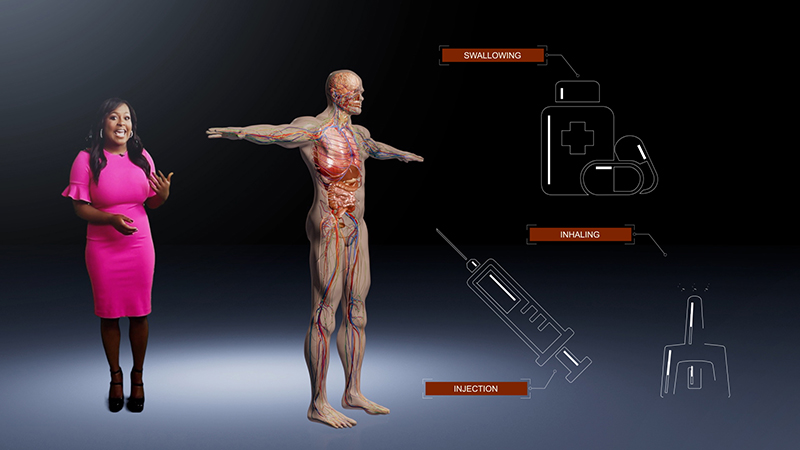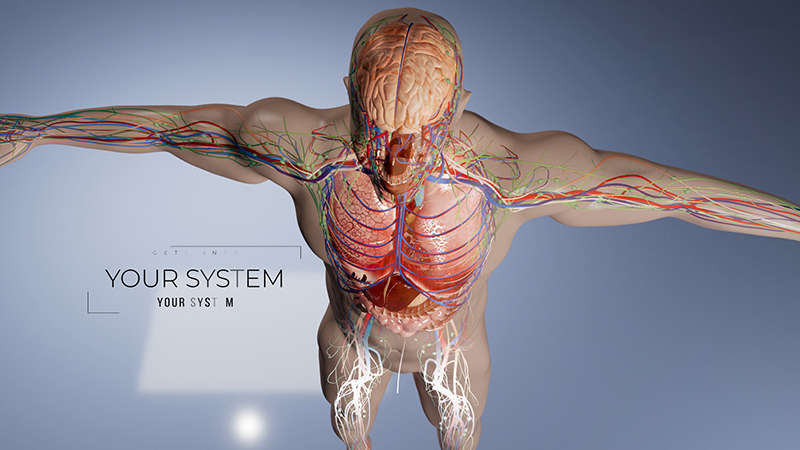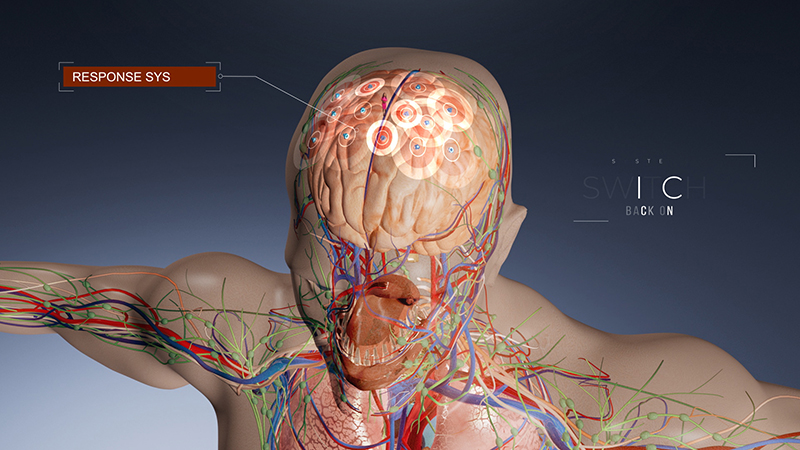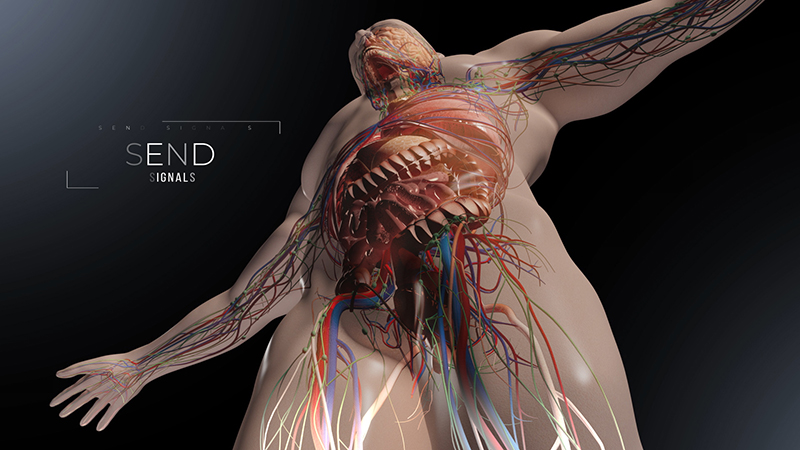A recent WRAL-TV story brought together the best of virtual design and reporting to explain an important concept surrounding the opioid epidemic. WRAL-TV Health Reporter Grace Hayba and WRAL-TV Visual Design Director Shan Zhong worked together to create a compelling and informative piece about how Naloxone – or Narcan – works to combat an overdose of fentanyl.
“It was a great collaboration between Grace Hayba, our health reporter, and Shan Zhong, our AR/VR artist with creative services,” said WRAL-TV Enterprise Executive Producer Ashley Talley. “It was definitely a different way to tell a whole story. We use the animations — lovingly called ‘Shanimations’ — in various stories, but this was unique in that nearly the whole thing was done in that form.”
Augmented Storytelling, Enhanced Understanding
Passionate about the work she has been given, Hayba considered how to tackle a key topic.
“From the time I started here, it quickly became evident opioid coverage would be a big part of my beat as the health reporter,” explained Hayba. “I began brainstorming ideas with Ashley Talley about how to talk about overdoses in a new way, going beyond just the statistics. We decided to hone in on fentanyl due to its deadly grasp on the state.”
Hayba continued, “Ashley first suggested finding a way to visualize what happens inside the human body during an overdose. When researching the science behind it all, I realized I wanted to also include the life-saving medication naloxone in the piece. We have repeatedly told viewers that it helps save lives, but we haven’t truly explained how.”
Then Zhong entered the picture. He has used his expertise in design on countless stories over the years.
“Since 2019, I started working with news and weather to create immersive mixed reality (newsroom calls it AR – augmented reality),” explained Zhong. “I do AR standups, packages, and weather explainers for stories that need enhanced graphics to better explain the topics. Grace’s story was one of them.”
“Opioid use, especially those which are illegally manufactured, is an epidemic the entire country is battling. The state reports from 2000-2022 alone, over 36,000 North Carolinians died from overdoses. When I read that statistic, I don’t just see numbers, but rather the thousands of mothers, fathers, sisters, brothers and friends lost. I thought it was important to remind people how an amount so small you can’t even see can kill you. We have recently reported on more harm reduction efforts aimed at increasing the supply of naloxone, including in Wake County Schools, so I wanted to ensure we incorporated a “solution” to the problem as well.”
–WRAL-TV Health Reporter Grace Hayba
Zhong’s augmented reality design and Hayba’s narration came together to show as well as tell viewers.
“The beauty of having Shan on our team is that it gives WRAL the ability to tell stories in ways others can’t,” Hayba told CapCom. “In writing the script, I felt the natural story arc was to begin with someone who first takes fentanyl, begins to overdose, and is then revived using naloxone.”
After talking through the concept with Hayba, Zhong got to work.
“In general, after going over the script with producers, I’ll create visual storyboards to plan out how anchors, reporters, and meteorologists interact with virtual graphics elements,” he said. “Then we do video shoots based on the storyboards, and finally complete the postproduction process.”
 WRAL-TV Health Reporter Grace Hayba (left) in the AR/VR studio with WRAL-TV Visual Design Director Shan Zhong, working together to produce a story about naxolone.
WRAL-TV Health Reporter Grace Hayba (left) in the AR/VR studio with WRAL-TV Visual Design Director Shan Zhong, working together to produce a story about naxolone.
He spent many hours creating the AR, and then the duo went into the studio to bring it to life.
“Shan made it really easy!” Hayba told CapCom. “This was my first time working on a VR project, so I wasn’t quite sure what to expect but he directed me through every shot and motion.”
The team shot Hayba in the AR studio over a green screen. Then the package was completed in post by compositing video and graphics.
“The reason I think Shan was able to knock this out of the park was entirely in his approach,” said Hayba. “He first met with me to go over my script and hear what my ideas were so that he could understand what the science was that I wanted to visualize. He then created a storyboard with sketches to walk me through how he planned to shrink my body inside the brain and move throughout the vital organs as they shut down. We did a few takes with varying arm motions to make sure nothing would be cut off when I was pointing at the naloxone or organs.”
 WRAL-TV Visual Design Director Shan Zhong created graphics in augmented reality to help tell a story by WRAL-TV Health Reporter Grace Hayba about naloxone and how it fights a fentanyl overdose.
WRAL-TV Visual Design Director Shan Zhong created graphics in augmented reality to help tell a story by WRAL-TV Health Reporter Grace Hayba about naloxone and how it fights a fentanyl overdose.
Hayba greatly appreciated the others on the WRAL crew who helped make the story happen.
“I also want to give a huge thank you to WRAL-TV News Production Manager James Ford and WRAL-TV Streaming Editor/Producer Khadejah Durant for helping coordinate the camera, lighting, audio and prompter!” she said. “It was really a team effort.”
And Hayba is grateful to have Zhong on the team to further the important story she wanted to share.
“I truly admire how he can take an idea in someone’s head and turn it into an engaging visualization that is even better than you imagined,” Hayba told CapCom. “Storytelling nowadays relies so much on keeping viewers connected and engaged with the piece. When you have a world of content at your fingertips, showcasing your story in new ways has become more important than ever. Shan’s work absolutely accomplishes that — and then some! His creativity is incredible, and I can’t wait to work with him further in the future!”
 WRAL-TV‘s Grace Hayba (center) in the AR/VR studio with WRAL-TV’s Shan Zhong (right) and WRAL-TV’s James Ford, working together to produce a story about naxolone.
WRAL-TV‘s Grace Hayba (center) in the AR/VR studio with WRAL-TV’s Shan Zhong (right) and WRAL-TV’s James Ford, working together to produce a story about naxolone.
See the story on WRAL.com:
Thanks to WRAL-TV’s Grace Hayba and WRAL-TV’s Shan Zhong for these CapCom photos & graphics.
Check out more of Zhong’s AR Projects on YouTube:
“Using Immersive mixed reality (AR) to help our reporters and meteorologists in creating and delivery news stories and weather specials is rewarding because sometimes it would be impossible to create visuals without using AR, especially for news and weather explainer packages like ‘Microburst’, ‘Storm Surge in Your Home’, ‘NC Wildfire’ and ‘Changing Ocean Currents’ etc.”
–WRAL-TV Visual Design Director Shan Zhong
 WRAL-TV Visual Design Director Shan Zhong created graphics in augmented reality to help tell a story by WRAL-TV Health Reporter Grace Hayba about naloxone and how it fights a fentanyl overdose.
WRAL-TV Visual Design Director Shan Zhong created graphics in augmented reality to help tell a story by WRAL-TV Health Reporter Grace Hayba about naloxone and how it fights a fentanyl overdose.
 WRAL-TV Visual Design Director Shan Zhong created graphics in augmented reality to help tell a story by WRAL-TV Health Reporter Grace Hayba about naloxone and how it fights a fentanyl overdose.
WRAL-TV Visual Design Director Shan Zhong created graphics in augmented reality to help tell a story by WRAL-TV Health Reporter Grace Hayba about naloxone and how it fights a fentanyl overdose.
 WRAL-TV Visual Design Director Shan Zhong created graphics in augmented reality to help tell a story by WRAL-TV Health Reporter Grace Hayba about naloxone and how it fights a fentanyl overdose.
WRAL-TV Visual Design Director Shan Zhong created graphics in augmented reality to help tell a story by WRAL-TV Health Reporter Grace Hayba about naloxone and how it fights a fentanyl overdose.
 WRAL-TV Visual Design Director Shan Zhong created graphics in augmented reality to help tell a story by WRAL-TV Health Reporter Grace Hayba about naloxone and how it fights a fentanyl overdose.
WRAL-TV Visual Design Director Shan Zhong created graphics in augmented reality to help tell a story by WRAL-TV Health Reporter Grace Hayba about naloxone and how it fights a fentanyl overdose.
 WRAL-TV Visual Design Director Shan Zhong created graphics in augmented reality to help tell a story by WRAL-TV Health Reporter Grace Hayba about naloxone and how it fights a fentanyl overdose.
WRAL-TV Visual Design Director Shan Zhong created graphics in augmented reality to help tell a story by WRAL-TV Health Reporter Grace Hayba about naloxone and how it fights a fentanyl overdose.